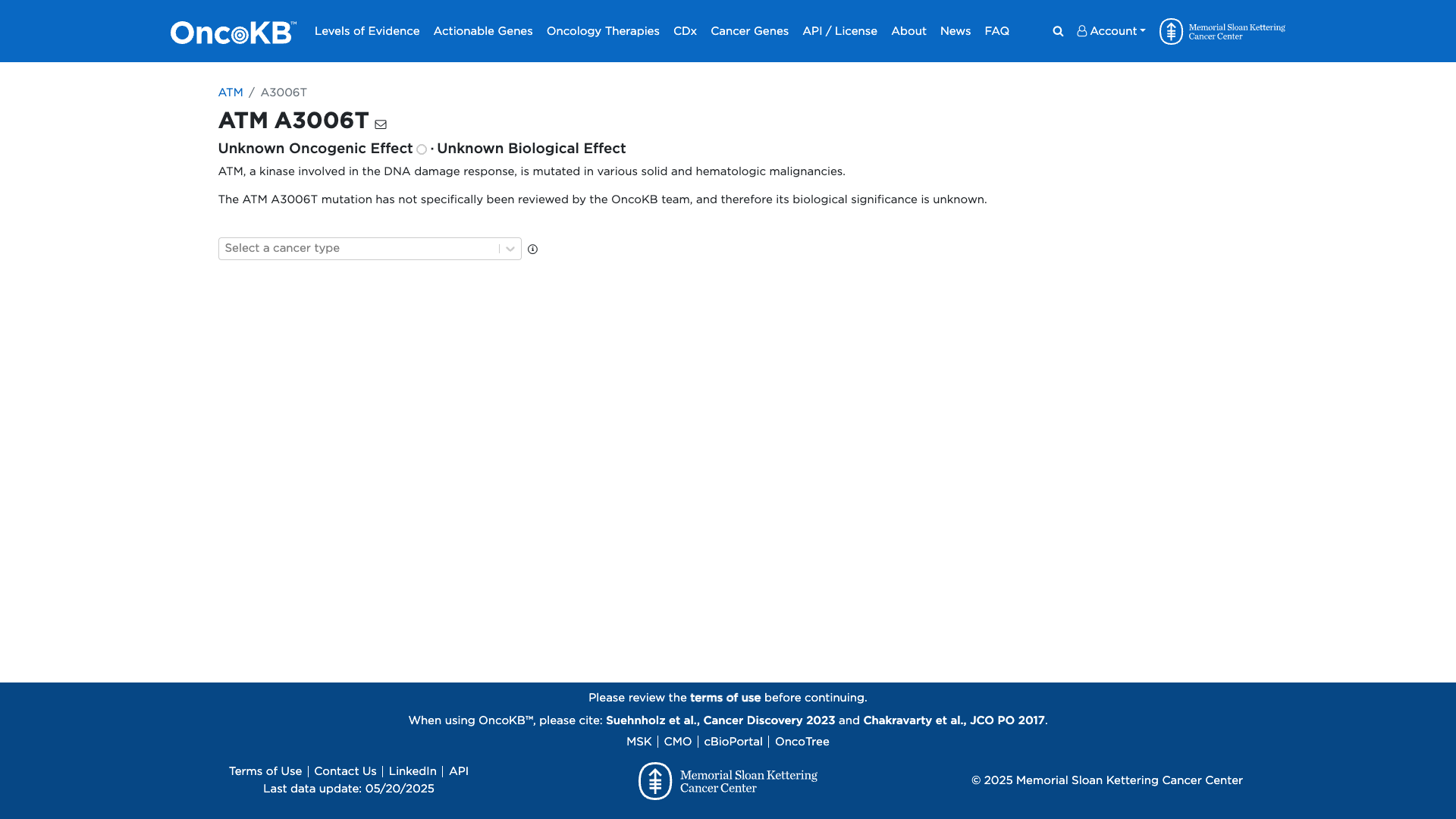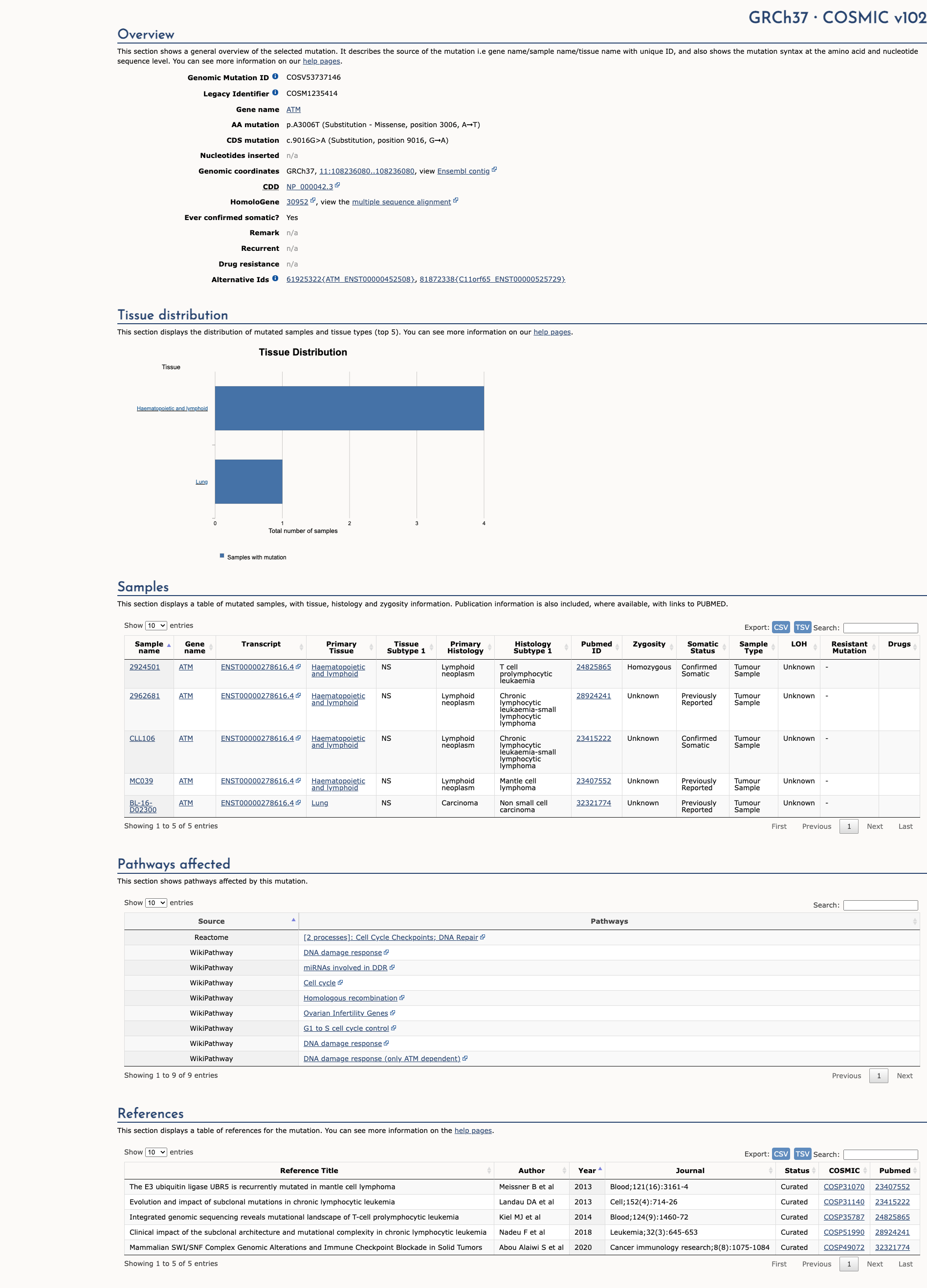ATM c.9016G>A, p.Ala3006Thr
NM_000051.4:c.9016G>A
COSMIC ID: COSM1235414
Variant of Uncertain Significance (VUS)
A3006T in ATM is absent from population databases (PM2_supporting) but lacks any additional pathogenic or strong benign evidence. In silico predictions are mixed and do not meet gene‐specific thresholds (BP4/PP3 not applied). No functional, segregation, or case–control data are available. Under VCEP ATM guidelines, the variant remains a Variant of Uncertain Significance.
ACMG/AMP Criteria Applied
PM2
Genetic Information
Gene & Transcript Details
Gene
ATM
Transcript
NM_000051.4
MANE Select
Total Exons
63
Strand
Forward (+)
Reference Sequence
NC_000011.9
Alternative Transcripts
| ID | Status | Details |
|---|---|---|
| NM_000051.3 | RefSeq Select | 63 exons | Forward |
Variant Details
HGVS Notation
NM_000051.4:c.9016G>A
Protein Change
A3006T
Location
Exon 63
(Exon 63 of 63)
5'Exon Structure (63 total)3'
Functional Consequence
Loss of Function
Related Variants
No evidence of other pathogenic variants at position 3006 in gene ATM
Alternate Identifiers
COSM1235414
Variant interpretation based on transcript NM_000051.4
Genome Browser
Loading genome browser...
HGVS InputNM_000051:c.9016G>A
Active Tracks
ConservationRefSeqClinVargnomAD
Navigation tips: Use mouse to drag and zoom. Click on features for details.
Clinical Data
Population Frequency
Global Frequency
0.0 in 100,000
Extremely Rare
Global: 0.0%
0%
0.05%
0.1%
1%
5%
10%+
ACMG Criteria Applied
PM2
This variant is not present in gnomAD (PM2 criteria applies).
Classification
Uncertain Significance (VUS)
Based on 2 submitter reviews in ClinVar
Submitter Breakdown
2 VUS
Pathogenic
Likely Path.
VUS
Likely Benign
Benign
Publications (0)
No publication details.
Clinical Statement
This variant has been reported in ClinVar as Uncertain significance (2 clinical laboratories).
Functional Impact
Functional Domain
Hotspot Status
Not a hotspot
Domain Summary
This variant is not located in a mutational hotspot or critical domain (0 mutations).
Related Variants in This Domain
No evidence of other pathogenic variants at position 3006 in gene ATM
Functional Summary
The ATM A3006T variant has not been functionally characterized, and its effect on ATM protein function is currently unknown.
Database Previews
OncoKB

JAX-CKB

Click on previews to view full database entries. External databases may require institutional access.
Computational Analysis
Pathogenicity Predictions
REVEL Score
0.49
0.49
Likely Benign0.0
Uncertain (Low)0.2
Uncertain (Med)0.5
Likely Pathogenic0.75
REVEL scores ≥ 0.75 are strong evidence (PP3)
Predictor Consensus
Mixed/VUS
PP3 Applied
No
Additional Predictors
Pathogenic:
polyphen_prediction: probably_damaging
Benign:
CADD: 4.98metasvm: Tmetalr: Tprimateai: T
Neutral: Show all
VCEP Guidelines
Applied ACMG/AMP Criteria (VCEP Specific) VCEP Guidelines
PVS1
PVS1 (Not Applied) Strength Modified
According to VCEP guidelines (ATM PVS1 Decision Tree): “Use ATM PVS1 Decision Tree” – A missense variant does not create a null allele. The evidence for A3006T shows it is a missense change with no predicted splicing defect. Therefore, PVS1 is not applied.
PS1
PS1 (Not Applied) Strength Modified
According to VCEP guidelines (PS1 Splicing Table): “Use for protein changes as long as splicing is ruled-out for both alterations.” No previously established pathogenic variant results in the same amino acid change A3006T. Therefore, PS1 is not applied.
PS2
PS2 (Not Applied) Strength Modified
According to standard ACMG guidelines: “De novo (both maternity and paternity confirmed) in a patient with the disease and no family history.” No parental testing or de novo confirmation data are available. Therefore, PS2 is not applied.
PS3
PS3 (Not Applied) Strength Modified
According to VCEP guidelines (PS3 gene-specific): “Use when a variant fails to rescue both an ATM specific feature AND radiosensitivity for Strong/Moderate; Supporting if fails to rescue an ATM specific feature only.” No functional studies have been performed on A3006T. Therefore, PS3 is not applied.
PS4
PS4 (Not Applied) Strength Modified
According to standard ACMG guidelines: “Case-control studies; p-value ≤.05 AND (OR ≥2 or lower 95% CI ≥1.5).” No case-control or cohort data are available for this variant. Therefore, PS4 is not applied.
PM1
PM1 (Not Applied) Strength Modified
According to standard ACMG guidelines: “Located in a mutational hotspot and/or well‐studied functional domain without benign variation.” There is no evidence that A3006 lies in a known hotspot or critical domain unique to ATM pathogenic variants. Therefore, PM1 is not applied.
PM2
PM2 (Supporting) Strength Modified
According to VCEP guidelines: “Supporting Strength: Frequency ≤.001% if n=1 in a single subpopulation, that is sufficiently rare and PM2_supporting would apply.” A3006T is absent (MAF = 0%) in gnomAD and other population databases. Therefore, PM2 is applied at Supporting strength.
PM3
PM3 (Not Applied) Strength Modified
According to VCEP guidelines (PM3/BP2 table): “Use for variants in trans with a pathogenic variant in recessive disorders.” No information on trans observation with a known pathogenic ATM variant is available. Therefore, PM3 is not applied.
PM4
PM4 (Not Applied) Strength Modified
According to standard ACMG guidelines: “Protein length changes due to in‐frame deletions/insertions.” A3006T is a missense change without alteration in protein length. Therefore, PM4 is not applied.
PM5
PM5 (Not Applied) Strength Modified
According to VCEP guidelines: “Supporting Strength: Use for genomic frameshift and truncating variants with PTC upstream of p.R3047.” A3006T is a missense variant, not a stop‐gain or frameshift. Therefore, PM5 is not applied.
PM6
PM6 (Not Applied) Strength Modified
According to standard ACMG guidelines: “Assumed de novo, but without confirmation of paternity and maternity.” No de novo assumption data are available. Therefore, PM6 is not applied.
PP1
PP1 (Not Applied) Strength Modified
According to standard ACMG guidelines: “Co‐segregation with disease in multiple affected family members.” No segregation data are available for A3006T. Therefore, PP1 is not applied.
PP2
PP2 (Not Applied) Strength Modified
According to standard ACMG guidelines: “Missense variant in a gene with low rate of benign missense variation where missense is a common mechanism of disease.” ATM has both missense and truncating pathogenic variants reported; no gene‐specific PP2 applies. Therefore, PP2 is not applied.
PP3
PP3 (Not Applied) Strength Modified
According to VCEP guidelines: “Supporting Strength: Protein: REVEL >.7333; RNA: at least one in silico predictor shows impact on splicing.” A3006T has REVEL 0.49 (<.7333) and SpliceAI 0.01 (no splicing impact). Therefore, PP3 is not applied.
PP4
PP4 (Not Applied) Strength Modified
According to standard ACMG guidelines: “Patient’s phenotype or family history is highly specific for a disease with a single genetic etiology.” No phenotype data were provided. Therefore, PP4 is not applied.
PP5
PP5 (Not Applied) Strength Modified
According to standard ACMG guidelines: “Reputable source reports variant as pathogenic.” ClinVar reports A3006T as VUS by two laboratories. Therefore, PP5 is not applied.
BA1
BA1 (Not Applied) Strength Modified
According to VCEP guidelines: “Stand Alone: Filtering Allele Frequency >.5%.” A3006T is absent in population databases (MAF 0%). Therefore, BA1 is not applied.
BS1
BS1 (Not Applied) Strength Modified
According to VCEP guidelines: “Strong: Filtering Allele Frequency >.05%.” A3006T has MAF 0% in gnomAD. Therefore, BS1 is not applied.
BS2
BS2 (Not Applied) Strength Modified
According to standard ACMG guidelines: “Observed in a healthy adult individual for a dominant disorder with full penetrance.” No such healthy adult observations are reported. Therefore, BS2 is not applied.
BS3
BS3 (Not Applied) Strength Modified
According to VCEP guidelines (BS3 gene-specific): “Moderate: Variant rescues both ATM‐specific feature AND radiosensitivity; Supporting: rescues either.” No rescue functional data are available. Therefore, BS3 is not applied.
BS4
BS4 (Not Applied) Strength Modified
According to standard ACMG guidelines: “Lack of segregation in affected members of a family.” No non‐segregation data are available. Therefore, BS4 is not applied.
BP1
BP1 (Not Applied) Strength Modified
According to standard ACMG guidelines: “Missense variant in a gene for which primarily truncating variants cause disease.” ATM disease is caused by both truncating and missense variants. Therefore, BP1 is not applied.
BP2
BP2 (Not Applied) Strength Modified
According to VCEP guidelines (PM3/BP2 table): “Strong/Moderate/Supporting: Observed in trans with a pathogenic variant.” No data on cis/trans phase with known pathogenic variants. Therefore, BP2 is not applied.
BP3
BP3 (Not Applied) Strength Modified
According to standard ACMG guidelines: “In‐frame deletions/insertions in repetitive region without a known function.” A3006T is a single amino acid substitution. Therefore, BP3 is not applied.
BP4
BP4 (Not Applied) Strength Modified
According to VCEP guidelines: “Supporting: Protein REVEL ≤.249; RNA: at least one predictor shows impact on splicing.” A3006T has REVEL 0.49 (> .249) and SpliceAI 0.01 (no splicing impact). Therefore, BP4 is not applied.
BP5
BP5 (Not Applied) Strength Modified
According to standard ACMG guidelines: “Variant found in a case with an alternate molecular basis for disease.” No such evidence exists. Therefore, BP5 is not applied.
BP6
BP6 (Not Applied) Strength Modified
According to standard ACMG guidelines: “Reputable source reports variant as benign.” No such report exists for A3006T. Therefore, BP6 is not applied.
BP7
BP7 (Not Applied) Strength Modified
According to VCEP guidelines: “Supporting: Use for synonymous or deep intronic variants.” A3006T is a missense change. Therefore, BP7 is not applied.

